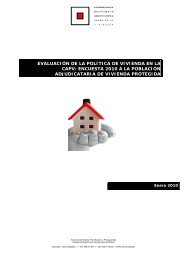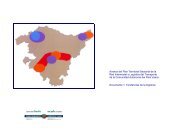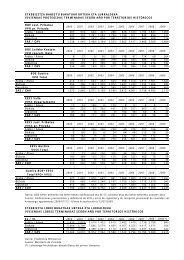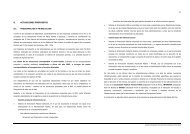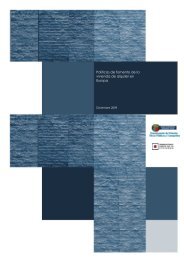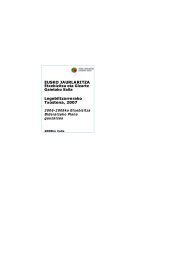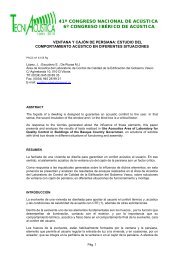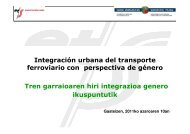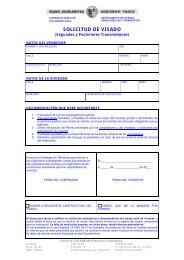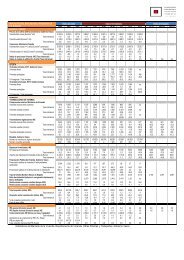2. análisis de la situación actual de la red viaria - Garraioak
2. análisis de la situación actual de la red viaria - Garraioak
2. análisis de la situación actual de la red viaria - Garraioak
You also want an ePaper? Increase the reach of your titles
YUMPU automatically turns print PDFs into web optimized ePapers that Google loves.
40,00%<br />
35,00%<br />
30,00%<br />
25,00%<br />
20,00%<br />
15,00%<br />
10,00%<br />
5,00%<br />
0,00%<br />
TRÁFICO EN LA RED FUNCIONAL DEL T. H. DE ÁLAVA (% KM)<br />
24,16%<br />
0-<strong>2.</strong>000<br />
<strong>2.</strong>000-5.000<br />
33,44%<br />
5.000-10.000<br />
5,65%<br />
AÑO 2003<br />
10.000-20.000<br />
18,67% 18,09%<br />
20.000-40.000<br />
40.000-80.000<br />
0,00% 0,00%<br />
Fuente: E<strong>la</strong>boración propia a partir <strong>de</strong> los datos <strong>de</strong> <strong>la</strong>s Diputaciones Forales.<br />
Con respecto a los datos <strong>de</strong>l 2º P<strong>la</strong>n General <strong>de</strong> Carreteras se observa que, en el Territorio Histórico <strong>de</strong><br />
Á<strong>la</strong>va, se ha incrementado el porcentaje <strong>de</strong> <strong>red</strong> que supera los <strong>2.</strong>000 vehículos día, así como los que<br />
superan los 10.000 vehículos día. Por el contrario, ha <strong>de</strong>scendido notablemente el porcentaje <strong>de</strong> kilómetros<br />
con IMD inferior a <strong>2.</strong>000 vehículos, así como el rango comprendido entre los 5.000 y los 10.000. En ambos<br />
casos, sigue sin existir ningún tramo en este Territorio Histórico que supere los 40.000 vehículos,<br />
pudiéndose percibir un incremento global <strong>de</strong>l tráfico en <strong>la</strong> Red.<br />
>80.000<br />
50,00%<br />
45,00%<br />
40,00%<br />
35,00%<br />
30,00%<br />
25,00%<br />
20,00%<br />
15,00%<br />
10,00%<br />
5,00%<br />
0,00%<br />
TRÁFICO EN LA RED FUNCIONAL DEL T. H. DE ÁLAVA (% KM)<br />
0-<strong>2.</strong>000<br />
<strong>2.</strong>000-5.000<br />
COMPARATIVA 2003 - 1996<br />
5.000-10.000<br />
10.000-20.000<br />
20.000-40.000<br />
2003 1996<br />
40.000-80.000<br />
Fuente: E<strong>la</strong>boración propia a partir <strong>de</strong> los datos <strong>de</strong> <strong>la</strong>s Diputaciones Forales.<br />
En el Territorio Histórico <strong>de</strong> Gipuzkoa, el porcentaje mayor <strong>de</strong> kilómetros se sitúa entre los 10.000 y los<br />
20.000 vehículos, superando el 25%. Destacan los tráficos entre los 20.000 y los 40.000, así como los que<br />
se sitúan entre 5.000 y 10.000, en ambos casos por encima <strong>de</strong>l 20%. Los tráficos superiores a 40.000<br />
vehículos tan sólo representan el 9% <strong>de</strong> <strong>la</strong> <strong>red</strong>, superando los 80.000 un porcentaje menor <strong>de</strong>l 1% <strong>de</strong> los<br />
kilómetros <strong>de</strong> <strong>la</strong> <strong>red</strong> guipuzcoana. Finalmente, por <strong>de</strong>bajo <strong>de</strong> los 5.000 vehículos se encuentra algo más <strong>de</strong>l<br />
22% <strong>de</strong> los kilómetros <strong>de</strong> <strong>la</strong>s carreteras <strong>de</strong> <strong>la</strong> Red Funcional <strong>de</strong> Gipuzkoa.<br />
>80.000<br />
220<br />
Revisión <strong>de</strong>l Segundo P<strong>la</strong>n General <strong>de</strong> Carreteras <strong>de</strong>l País Vasco



